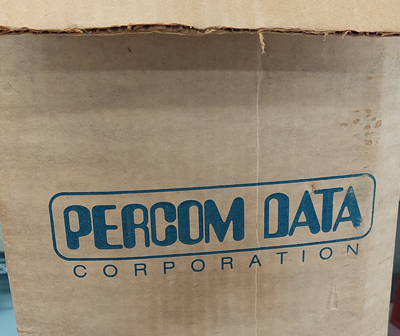9 June 2023
 Click images for larger view
Click images for larger view
Here is how the Percom product line developed over time along with a description of each hardware and software offering. For some products there is an archive containing additional information.
This product archive is a work-in-progress and I'm in need of any software or documentation or hardware you have saved.
See the index of all Percom product information.
In September 1976 the CI-810 cassette interface board appeared in Byte magazine. It used Harold's circuitry to reduce errors that he talked about at the Kansas City Standard meeting in 1975. The product was a circuit board that the hobby computer user had to wire to their computer and tape drive. At this time Harold was working out of his house in Garland and Percom was a sole-proprietorship.
By December of 1976 the 'Lil floppy' disk drive ad appeared along with the CI-810. The disk drive was shown as a line drawing so I suspect it was still in development. This became the 'LFD' series of disk drives which was targeted to the SS50 bus used by SWTPC and others - 'L' = Little and 'FD' = Floppy Disk. This 3-character naming scheme continued through many other future drive products. The transition from cassettes to floppies was in its infancy.
In January of 1977 the CIS-30+ cassette interface appeared in ads. This product had a nice metal enclosure but the user still had to wire it to the computer. There was not a non-plus product. Also in January appeared the CI-812 which was an S100 board with dual cassette interfaces. S100 was a dominant computer bus at the time for more expensive systems.
By March of 1977 the Li'l floppy ad appeared with a real picture. Later that year SWTPC in San Antonio also introduced a mini-floppy system. Around that time Percom introduced a high-quality cassette tape made for data storage called Pilon.
I have found some assembly language code that has Harold's name on it but I think most software was written by Jim Stutsman and others. The LFD-400 was a fairly successful product for SS50 bus users and sold for several years.
Late in '77 Percom moved to their first building outside of their home to Barnes St., and Percom formally incorporated.
In July of '78 the TFD series of drives for Tandy model I computers appeared. Tandy ruled the computer market during those years before the IBM PC came around in '82 - silver and black was the color scheme.
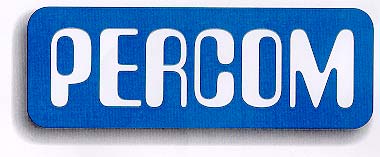
Harold liked the SS50 bus which was used by hobbyist more than the S100 bus which was more expensive and often used by business so he embarked on several products for the SS50 bus including a CPU board, video controller, prototype boards, serial board, etc. This was not a huge market and SS50 struggled behind S100 in the computer market until the IBM PC in '82 which changed the everything.
When Tandy/RadioShack released their first TRS80 computer in 1977 it had a design flaw on the disk controller which lead Harold to develop the Separator board in 1980. This product was a big hit and logically lead to the Doubler later that year which was also a small adapter board but it doubled the capacity of disk drives. Doubler was a huge hit with tens of thousands sold.
There became a swarm of 'FD' product lines to cover TRS80 I/III, Heathkit H8 and eventually Atari 400/800. NO APPLE PRODUCTS, Harold stayed away from that with one exception I can find which was a packaging product for an Apple II - I don't think it ever went to market. In 1980 Percom was known as the disk drive company for the growing consumer computer market.
In 1979 Percom moved to the 10k square foot building on Kirby St.
In parallel to the floppy drive products there were experiments in other unique products that larger companies would never try - one is the Speak-2-me-2 which used a TI Speak-N-Spell toy and interfaced it to a computer. It wasn't a big seller but very interesting. In those days we weren't sure which way people were going to settle on interfacing to a computer, would it be just a keyboard, or a light pen or a mouse or all audio, we just tried things and let the market decide.
Another unique product was the Electric Crayon box which connected a computer (almost any computer) to a color monitor to display graphics separately from the main terminal. These and a few other products launched in 1980.
As an almost irrelevant side note, Harold offered some boards for Motorola's EXORciser Bus machines starting in 1979 including a disk drive controller and a video controller. I never saw any of these sell but they probably did sell a few because the ads ran for about 2 years. This was an incredibly tiny market of companies who bought expensive EXORciser machines for product development, but it wasn't known how all these markets would pan out.
Each of these hardware products had software and patches and applications and documentation that went along with them so it wasn't all Harold. Stutsman wrote much of the software, McClintock wrote most of the manuals and ad copy.
Ultimately the SS50 bus products dwindled and TRS80 products ruled the world for a year or 2 until the IBM PC appeared. The PC became accepted by the masses and the hobby products didn't have a chance and gaining market share. Percom offered drive systems for the PC but the competition was strong with mass production from big companies and I don't think the numbers worked very well.
Meanwhile in the hobby market Atari was growing and a drive system for Atari 400/800 was launched to great success. This was at the time we grew up to about 150 employees. Late in 1981. Around this time was the move to the huge Pagemill building and the courting of investors which came with a lot of new people who where put in top positions. This was a tense time for the core people who built the company up from scratch.
One of Harold's big goals was an affordable hard disk system. That was a pretty difficult project technically and the tech industry was moving extremely fast. In 1982 he and others were working on one for the PC. Harold got sick in the fall and passed away.
The hard disk was eventually launched after Harold passed but company finances were going south. This was a tumultuous time for the tech industry and thousands of companies were either acquired or bankrupted. Percom went on to try a few more things including a network card in 1984 but I believe that was the last product.
You can still find Percom products on Ebay.
Products that Percom designed, manufactured, or distributed, roughly order of introduction...
Percom's very first product was the CI-810, a general purpose dual cassette tape interface with a parallel output on a 44-pin card edge board.
It was designed to be used with any kind of computer and required custom wiring.
At that time standard audio cassette players were used to store programs and data for hobby personal computers - the reliability was terrible. Harold was very interested in the problem of data extraction since the Collin's Radio days and solved it with some clever circuitry.
The first ad can be found in
Byte Magazine's September 1976 edition.
Ads seem to peter out by January of 1977 when the CI-812 S100 bus board appears.
The ad shows the home address so this was before the first building on Barnes St.
See the CI810 archive.

The second product introduced was the CIS-30+ cassette interface in a nice metal box designed to sit next to a computer.
This lead to the CIS-30+ which was a small box that connected a cassette player to a computer with a common serial port.
The first CIS-30s were built in a building in Harold's back yard before moving to the Barnes building.
See the CIS30+ archive.
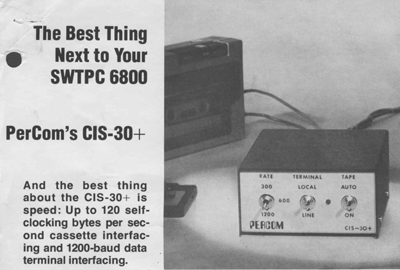
The third product was the Li'l floppy and was eventually named LFD - 'little floppy disk'. This 3-letter naming convention would continue with future products. The LFD disk controller and drives were initially targeted to the SS50 bus used by SWTPC and others. The first ad I found was Byte Magazine December 1976 where it is shown as a line drawing. Notice the enclosure has the drive horizontal. Later in the March 1977 edition of Byte Magazine the Li'l floppy is shown with a real picture, along with the CI-812 cassette interface for the S100 bus.
The first LFD drives were Shugart SA400 but later Siemens, MPI, Wangco, Micropolis and other manufacturers were used.

The fourth product introduced was the CI-812 cassette interface and a serial port on an S100 bus card.
S100 was a common bus used for 8080 and Z80 computers at the time.
The first ad I found was Byte Magazine March 1977
along with the Li'l floppy.
See the CI812 archive.
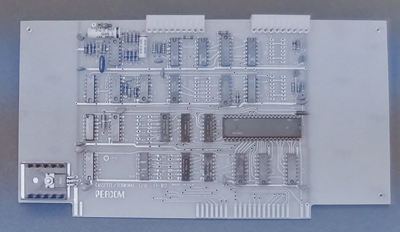
This was a Percom-labeled high-quality cassette tape they sold.
It came in a -10 and -30 version.
See the Pilon archive.
The Electric Crayon was a box that interfaced with a computer that connected to regular TV to produce color graphics under programmable control.
It came with an interface and drivers made for the TRS80 but it could be connected to other systems via a parallel port.
The Electric Crayon was in production in mid 1980.
The January 1981 80Microcomputing magazing had an Electric Crayon on the cover.
See the Electric Crayon archive.
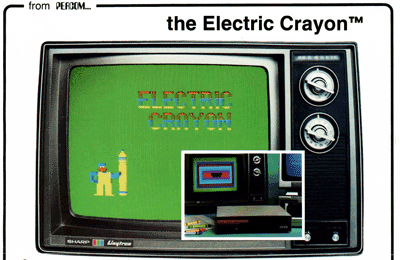
The Electric Window is a memory mapped video card for SS50 Bus computers using the SMS 5027 chip.
The output was composite video and could be connected to a TV with an RF modulator.
A character generator is provided in a 2708 EPROM.
Keyboard attachment to a PIO was provided for in the driver.
This could eliminate the need for an expensive terminal.
The WINDEX driver was written in 6800 assembly by Cliff Rushing with additions by Phil Sanders in summer 1980.
Appeared in Byte Nov 1979.
See the Electric window archive.

Colorama-50 is a color graphics controller for the SS50 bus.
The 8k screen memory is mapped in the CPU's upper memory area.
The board also offers a cassette I/O option and a 2K ROM socket.
See the Colorama-50 archive.
The Speak 2-Me-2 product was a circuit board that converted a TI Speak-N-Spell into a computer controlled voice synthesizer. 1980.
The kit was primarily sold for the TRS80 computer but it could be adapted to other computers.
I remember there being problems with TI changing their circuit boards and us having to re-trace the PCB layout to make the product work.
See the Speak 2-Me-2 archive.
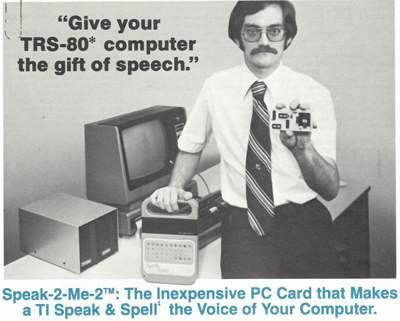
When Tandy/RadioShack launched the TRS-80 personal computer they quickly became the market leader with their silver and black machines. By that time people were switching from Cassettes to mini floppy disk drives. But there was a technical problem with the Model I computer, the floppy disk controller used the internal data separator of the 1771 chip and it was unreliable, very much so. The chip maker even says in the databook not to use it but Tandy didn't likely have the technical skill to design a clean data separator circuit.
So, this is where Harold saw an opportunity for a product, especially since he had already figured out a lot of this with the cassette tapes. So he designed a small board called 'The Separator' that fit under the 1771 chip on the TRS-80 model 1 to fix the problem. The Separator board was a hit and they sold thousands.
See the Separator archive.
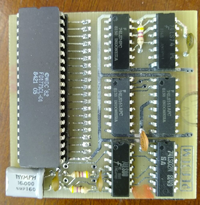
The Percom Doubler was a small circuit board like the separator but it had a double density controller on it which
allowed a TRS80 model I to double the capacity of the floppy disks. It was mostly plug-n-play and some small software modifications.
The user simply pulled out their controller chip and put it into the Doubler's socket, then install the board where the chip went.
Doubler was an amazing product and Percom sold thousands of them around 1980-1982. The price was around $170.
See the Doubler archive.

Percom distributed the Newtech model 68 music board for the SS50 bus.
See the Newtech archive.
The TFD mini floppy disk drive series of products were for TRS-80 model I and model III computers.
Tandy ruled the personal computing market before the IBM PC hit in 1982, and even for a little while after that.
TFD drives came in many flavors and sizes.
This was a huge product for Percom and provided 7 digit sales in 1980.
See the TFD archive.
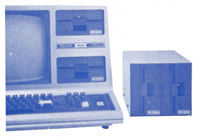
Heathkit computers were popular among hobbyists and in 1981 Percom eventually offered a disk controller and disk drive system for the H8 and H89 Heathkit computers.
Heathkit also offered a DEC PDP/11 compatible system called the H11 but Percom never made any product for DEC's QBUS.
This was a very small seller for Percom.
See the Z-Line archive.
Harold's affinity for the SS50 hobby computer bus lead him in late 1981 to offer disks, controllers and adapters to interface to various single board computers
including AIM, KIM and SYM.
This allowed him to leverage his other SS50 bus products to new markets.
These were not popular products at all.
See the M-Line archive.
As Atari moved from pure video game systems into the computer market, Percom launched drives for their 400 and 800 computers in 1982. The drive box had Percom's own controller inside and the software was written in-house by Darron S. There were single sided and double sided drives, 40 and 80 track, single and double density. The series was called 'RFD' but I have no idea where the 'R' came from. This was the biggest selling product for Percom ever with several $m sold. See the RFD archive.

Motorola, makers of the 6800, 6809 and other CPU chips, also offered their own computer bus called EXORciser. This 86-pin bus mostly stayed in the realm of developers and was very expensive, outside the reach of most hobbyists. Harold tried to break into this market by offering a series of EXORciser bus compatible products. EXORciser bus offerings included the LFD400EX and LFD800EX floppy drives systems with an EXORciser bus controller. Also offered was the VC-EX video controller board and the M64EX memory card.
An ad in Byte's November 1979 edition shows LFD-400EX and 800EX drive systems,
and also in '68 Micro Journal's September 1979 edition.
The brochure for the SS50 designer boards also mentions a 5-slot EXORciser motherboard named MBEX86.
See the EXORciser Bus archive.
MPA2 is an adapter board that allowed a 6800 CPU board to accept a 6809 CPU chip.
See the MPA2 archive.
Introduced in June 1979.
Byte 1979 Nov ad shows Percom's SS50 designer series boards.
The product line included an SS50 motherboard, SS30 motherboard, extender cards, and SS50 and SS30 prototyping cards.
See the SS50 board archive.
The SIO board was part of Percom's SS50/SS30 bus product line.
See the SIO archive.
SBC/9 was a 6809 CPU board for the SS50 bus introduced in 1979.
The socket could accept a 6802 or 6809 CPU chip.
The board also had a serial port, baud rate generator, parallel port, 1K RAM, 1K ROM for PSYMON system monitor and additional 1K ROM socket.
The board could be configured for 1M address space which hijacked the baud rate signals on the SS50 bus.
I have a raw SBC/9 PCB showing FRONT and BACK.
See the SBC/9 archive.

There's a mention in 68 Micro Journal's July 1979 edition of Percom offering an 8" drive system for SS50 bus systems. To my knowledge this never happened but it's possible it did for a short time before I got there.
Hard disks were the next logical step for Percom.
PHD was the 3-letter designation.
It ended up being technically challenging and the speeds involved were not suited for Harold's style of design and required some LSI chips.
This product was in development for a long time and went through several versions and several other engineers got involved.
This was the last product Harold worked on before his untimely passing in Aug 1982.
See the PHD archive.

I don't know much about these products since they happened about a year after I left.
PerComNet is a PC-compatible full-length networking card and uNETix is a single-user Unix work-alike operating system.
Percom purchased a piece of Lantech, makers of uNETix, in hopes of breaking into the PC networking market which was the next frontier.
I saw it written that PerComNet was licensed to Western Digital and sold as PC-LAN.
According to Dan B. this was a working product and was in production.
See the PerComNet archive and the uNETix archive for what I've found so far.
In the early '80s there was a big push from the FCC to regulate the electrical emissions of personal computers as they became adopted by the masses and used in homes near radios and TVs. This process was scary for small companies because the process was technically difficult, expensive, and very time-consuming - this gave larger companies an advantage. The results were often unfair and misguided - the whole problem was overblown and never became the crisis it was claimed to be. There were stories of the FCC sending agents to computer trade shows, dominated by small companies, and would shut them down right there on the spot if they didn't have the proper stickers.
In 1981 Percom took its TFD Tandy disk drive system down the street to E-Systems who had a RF testing lab. It was expensive. We setup a Tandy Model III computer with Percom disk drives and it failed the emission tests. We worked and worked, day after day, trying different shielding schemes, different cables, different software, but nothing worked. We even turned the drives off and it still didn't pass! Someone got curious and decided to test the Tandy computer all by itself, after all, it had an FCC compliance sticker. Well, come to find out, the Tandy computer didn't pass either. I don't remember what ended up happening but FCC regulations were a thorn in Percom's side from then on, and ultimately contributed to putting Percom out of business.
Software that Percom wrote or distributed or modified, roughly in alphabetical order...
DblDOS (DoubleDOS) was a set of patches to update Tandy's TRS80 operating system on the model I for use with double density adapter and drives from Percom.
See the DoubleDOS archive.
DoubleZap-II/80 was a patch for NewDOS/80 to use double density drive systems using a Percom Doubler adapter.
DoubleZap-II/V was a patch for VTOS V4.0 to use double density drive systems using a Percom Doubler adapter.
See the DoubleZAP archive.
INDEX is an expandable operating system for 6800 CPUs with an LFD disk drive system that uses interrupt-driven I/O for console and disk.
See the INDEX archive.
General purpose database and query software.
See the Finder archive.
General ledger accounting program.
See the Ledger archive.
Mailing list program.
See the List Processor archive.
MicroDOS was introduced in 1979, written by Jim Stutsman working for Percom, and released through Percom.
MicroDOS is an operating system for TRS-80 model I computer which didn't use a command shell like TRSDOS but used extensions to BASIC.
MICRODOS had no file system by itself, it used utilities for that, all disk accesses were made using the starting sector and length.
It was incompatible with TRSDOS disks.
See the OS-80 / MicroDOS archive.
Disk operating system for SWTPC SS50 systems.
See the MiniDOS archive.
MPX is a 2K disk operating system for the 6800 CPU.
It works from EPROM/ROM (usually 2 1K)
MPX provides low-level calls to disk drives via the LFD400 disk controller on an SS50 bus.
In addition to the EPROMs, a diskette is provided for additional functions.
See the MPX/9 archive.
MPX/9 is 1K disk operating system for the 6809 CPU.
The code is relocatable because the 6809 had relative calls and jumps.
Like MPX, it providing low-level disk function calls through the LFD400 controller on an SS50 bus,
and came with a diskette with additional functions.
See the MPX/9 archive.
NewDOS+ developed by Apparat and distributed by Percom.
Fixes for Tandy TRSDOS.
See the NewDOS archive.
Popular 6809 OS modified by Percom for use with LFD-400 disk drives.
See the OS/9 archive.
Formerly MICRODOS. BASIC-language disk operating system. See above.
There was an OS-80D for double density drive systems using a Percom Doubler adapter.
See the OS-80 / MicroDOS archive.
In 1979 Percom released the PSYMON system monitor for the 6809 SBC/9 board. Basically a tiny operating system. It's written in 6809 assembly and consumed only 1K of EPROM. Written by Harold Mauch, Mike Foreman, Byron Seastrunk, Cliff Rushing and Jim Stutsman (Chief).
PSYMON had commands to examine and change memory, load and save programs from cassette, jump to programs and various debugging features. PSYMON also provided utility calls for other programs to compare strings, hex I/O, console I/O, etc
Version 1.2 revision A is dated 11/23/79 and revision B dated 2/8/80. It appears there was a version for Tandy's Color Computer and for Motorola's EXORcisor boards.
See Oct 79 '68 micro journal review.
See the PSYMON archive.
Super BASIC is a 12K BASIC language interpreter and was available in both 6800 and 6809 CPU code.
It can work together with MPX/MPX/9 EPROMS.
See the SUPERBASIC archive.
Is a program that translates soft-sectored disks from most other vendors to Percom's hard-sector'd LFD400 format.
See the SofTran archive.
There were several more software offerings by Percom, some developed internally, some distributed from others.
See the Software archive.
See the desk archive.
See the binder archive.
Percom offered repair services for all their products.
When manufacturing moved to Pagemill, the Kirby building was used exclusively as the service center with about 5 people.
See the service archive.
See the box archive.
